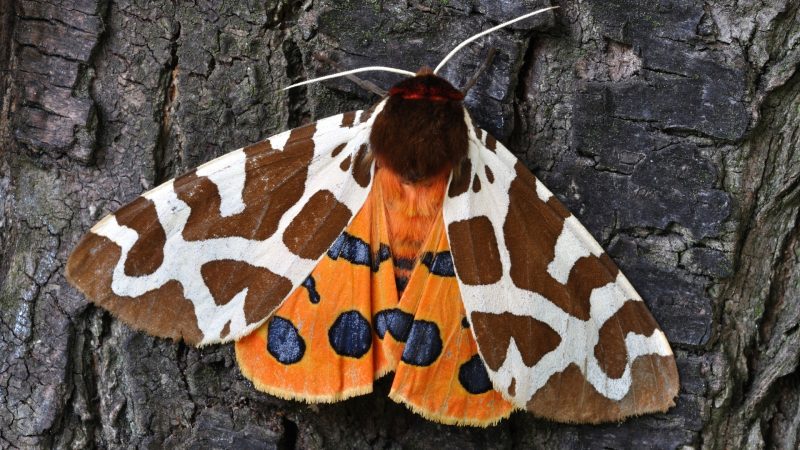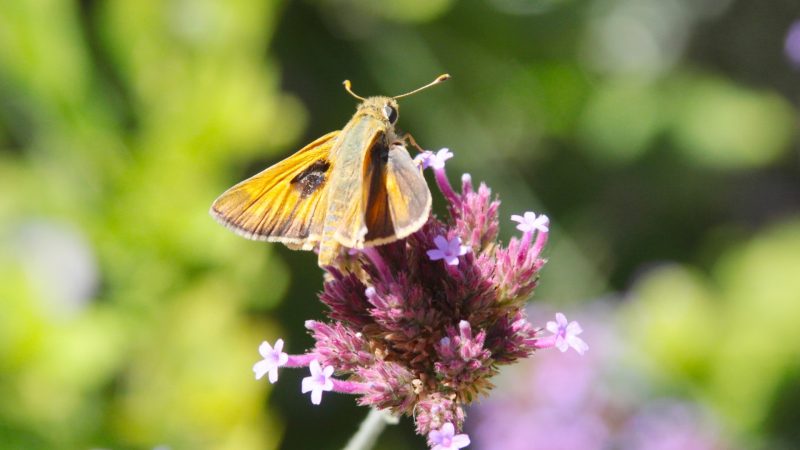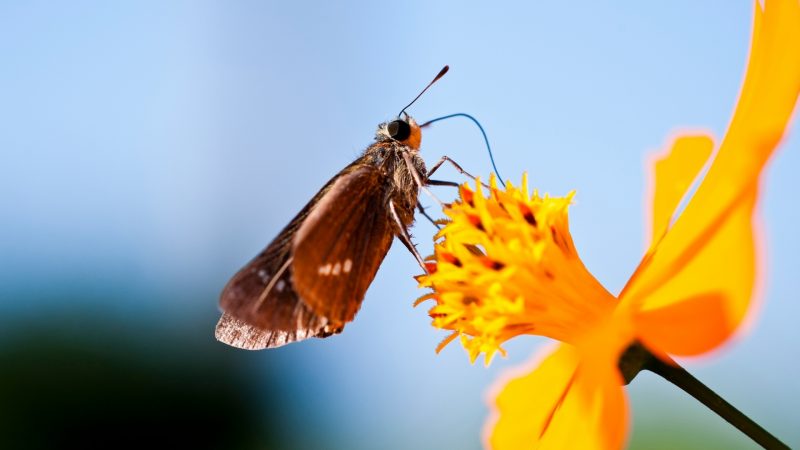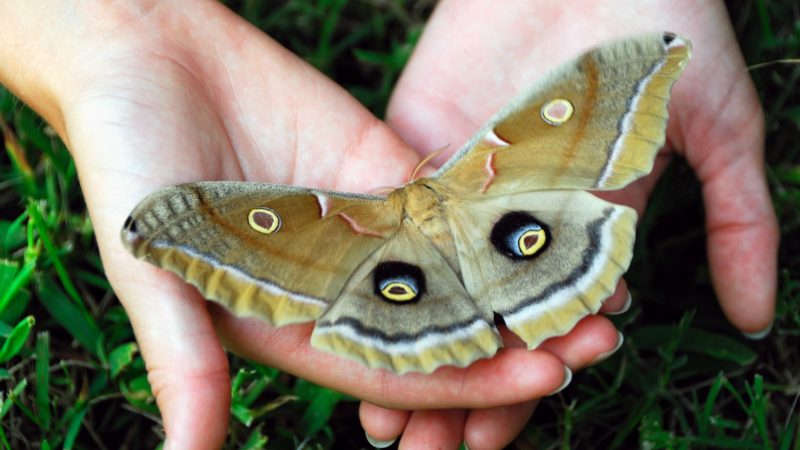Moths are famous for their beautiful and enchanting wings. They typically fly at night, so these adorable wing structures are commonly seen during dusk time. This is because most of them are nocturnal in nature. They become active as the sun sets to search and hunt for food.
What do moths eat? Adult moths eat very little food and survive on a liquid diet. Most of the moths consume liquids such as flower nectar, tree sap, fruits, animal droppings, and dung. Their favorite flowers include daisy, bluebell, and jasmine, while their preferred fruits are peaches, pears, apples, strawberries, and grapes.
Now that you have acquired information on what keeps a moth active and vigorous during the night, let us get to know more about these beautiful winged insects. In this article, we will cover their nature, traits, behavior, diet, and the natural enemies that devour and eat them.
What Exactly Is a Moth?

A moth is an insect belonging to the order Lepidoptera, class Insecta, Phylum Arthropoda. They share the same order as butterflies but are more prevalent than the latter as there are approximately 160,000 species of moth all over the world.
Just like the butterflies, they are famous for the attractive designs of their wing structures due to their striking colors and unique patterns. However, their antennae are feathery, unlike those of the butterflies which are long and thin.
Each moth goes through four life stages, namely egg, larva, pupa, and adult. Moths are nocturnal creatures, but some are crepuscular and diurnal in behavior. They usually go active during the evening to look for food and perform other daily functions. One of which is their duty as a pollinator through the transfer of pollen grains from one flower to another.
They are considered a popular food choice for animals like birds, spiders, bats, small rodents, lizards, and other insects. However, they are regarded as pests due to their ability to cause economic damage to hardwood trees, grains and flours, vegetables, ornamental plants, and agricultural crops.
Do Moths Drink Water?

To maintain and promote the water balance of their bodies, moths typically sip on nectar from flowers and other liquids such as tree saps, animal dung, rotting and fermenting fruits, and bird droppings. Other than that, these substances are also ingested so that they can preserve and sustain the energy they need to fulfill their day-to-day activities.
What Do Moths Eat? | List of Food
Moths are amazing animals. They can survive in a variety of environments, which allows them to consume a variety of substances. Additionally, they consume a variety of foods, including leaves, plants, flowers, and even your favorite item of clothes.
Here is a lengthy list of several foods that moths eat.
1. Bugs
These seemingly peaceful critters are actually predatory. Even worse, certain moth species show cannibalistic characteristics and occasionally eat their siblings. The following moth species are known for using these feeding techniques:
- Harvester Moth
- Cherry Gall Azure
- Planthopper Parasite Moth
- Kermes Scale Moth
2. Flowers Nectars
Many flowers and moths are night creatures. They are necessary for the pollination of these flowers that bloom at night.
The proboscis, a beak on the adult moths that consume flowers, is a tube-like structure that allows them to consume the nectar, sap, and keratin of these flowers.
Moths are drawn to blooms that are white or yellow because of their strong brightness even in low light. The moths are beneficial since they pollinate these blooms while they are out nocturnally.
3. Clothing
Clothes moths consume anything they can find, despite the majority of moths not. They act in this way during the larval stage of their life cycle. However, the harm they produce as larvae is typically catastrophic.
Webbing clothes moths (Tineola biselliell) and Case-making clothes moths (Tinea pellionella) are two well-known species that consume fabric. Both species are known to consume natural fabric fibers, including those in bedsheets, curtains, carpets, and upholstery, as well as clothing. Wool, cotton, silk, cashmere, and lint are all materials they can eat.
4. Cereals
The pantry moth is known for eating anything edible it finds in homes. If they get inside your house or pantry, they could cause you a serious problem.
Pantry moths eat like there’s no tomorrow. Your cereal, nuts, flour, dried fruit, chocolate, herbs, spices, and other food items will all be readily consumed by them.
5. Seeds
Caterpillar moths consume plant seeds. Some of them consume crops like sorghum, corn, and sugarcane. They do major harm to these crops when they feed on them, which can lead to severe financial difficulties for farmers.
What Do Moths Eat In the Wild?

When a moth stays in the wild, it will probably hoard all the nectar it can get. Since they mainly rely on this food source, they will hop from one flower to another to extract its sweet juices.
They are typically enticed by flowers that have sweet scents and heavy fragrances such as night-blooming Jasmine, Madonna lily, evening Primrose, sweet rocket, and dandelion. Other than that, they may also eat saps of forest trees and dung of wild animals that may be present in the said area.
What Do Larvae Eat?
Moth larvae or caterpillars are usually hatched in the leaves of their plant hosts or woolen and silk cloths. They are considered voracious eaters and will stack on food as much as they can. Also, they will munch on leaves with all their might. So, don’t be shocked if part of the plant and tree leaves they’ve infested is riddled with holes and irregular cuts.
Those moths that are found in gardens and farms may ingest organic materials, fruits, and vegetables like broccoli, tomatoes, Brussels sprouts, tobacco, pear, and apples. Other than that, they may consume fabrics that originally came from animals such as wool, fur, silk, cotton, felt, leather, and feathers.
They take these plant and fiber materials into their system because it is necessary for their maturity and transformation. Also, there is a tendency for their skin covers to be shed multiple times because their integumentary system can hardly cope with their eating habits.
What Does Pupa Eat?
Once a moth larva grows and becomes 1 ½ to 2 ½ inches in length, it will begin to undergo the pupal stage. During this time, they will go down and look for places where they can develop and transform into adult moths. This includes bark ridges underneath tree branches and loose tree barks, firewood piles, and other areas where they can safely hide from predators such as birds, spiders, mice, and wasps.
While they pupate and hide in their cocoons, they will not usually eat and ingest food. What they have consumed from the larval stage will serve as their source of energy and strength.
What Do Adult Moths Eat?
When a pupa transforms into an adult moth, it will now feed on the sweet juices of flower nectars, honeydew, and tree saps. However, they will also suck on the liquids of rotting fruits, animal droppings, and manure. They will use their long and tube-like proboscis to get the water from these sources through a distinct pumping mechanism.
The juices they have extracted will serve as their fuel and energy in flying and performing acts of reproduction. Their favorite nectar sources include daisy, jasmine, sweet rocket, evening primrose, petunia, dandelion, and bluebell.
Furthermore, different adult moth species may eat varying food items. For example, pantry moths are greatly attracted to grain products such as rice, cereal, cornmeal, nuts, and flour, but they can also munch on pet food, birdseed, dried fruits, and dried pasta. On the other hand, clothes moth larvae are huge fans of fabric materials made from animal fibers like felt, silk, wool, fur, leather, and feathers.
What Do Moths Eat and Drink in the House?
Certain moth species enter and invade the houses to search and hunt for food. This includes the pantry moth, an insect that is notorious for infesting kitchens, pantries, and other areas where food is kept.
Pantry moths typically feed on grains, cereals, flour, wheat, cornmeal, bread, pasta, and other food items that are dried and processed commercially. Additionally, they may enter through open doors and windows, as well as gaps and crevices in vents and cables.
Related: How to Get Rid of Pantry Moths Naturally? | Information and Control Guide
Do Moths Eat Cotton?
Clothes moths usually prefer fabric materials that are made from animals, such as wool, fur, silk, felt, and feathers, but they may also consume the natural fibers from cotton. This means that moth species are avid fans of drapes, pieces of clothing, carpets, and bedding that are made from animal-based fibers.
These insects usually reside in dark and concealed areas such as cabinets, chests, and boxes. So, the clothes and fabrics that are stored in these areas are at high risk for damage from a possible clothes moth infestation.
Do Carpet Moths Eat Clothes?
Carpet moths are greatly attracted to fabric materials that contain keratin, a protein that can be found in the skin, nails, hair, and cells of humans and certain animals like mammals, amphibians, reptiles, fishes, and birds. This protein is widely found in wool and alpaca fabrics. So once your clothes, fleece covers, and beddings are made from these fibers, carpet moths may attack and eat them.
Do Moths Eat Plants?
Most of the moth larvae will feed ravenously on leaves if a plant happens to be their host. They can consume large amounts of green foliage that are necessary for their transformation and tissue development. Moreover, they may chew on vegetables and organic materials that will be stacked up until they reach the pupal or adult stage. This includes Brussels sprouts, tomatoes, and broccoli.
However, they may also like fruit-bearing plants such as strawberries, apples, pears, peaches, grapes, and watermelons. This is the reason why they can be economically significant in the deterioration and damage of agricultural crops.
Do Moths Eat Ants?
Moth species that are carnivorous in nature typically munch on aphids and soft-bodied insects. This also includes ant creatures. There is a tendency for moths to eat almost any edible item.
What Moths Don’t Eat?
There are various plants that moths avoid due to their scents and odors. They abhor the aroma of thyme, rosemary, lavender, cedar, bay leaves, and cloves, so they will avoid these plant items. Also, they will avoid food items mixed with a vinegar solution or fabric materials made from vegetable fibers, as moths that feed on cloths prefer animal protein filaments.
Nevertheless, other adult moths don’t consume anything as they can survive by depending on the food they have eaten during their time as caterpillars.
Can Moths Bite Humans?

It is unusual for moths to bite humans as they are generally peaceful creatures. They spend the majority of their time on flowers and plants. Because they are most active at night, they are less likely to approach people.
However, if an individual happens to have skin contact with an adult moth or moth larvae, they may experience Lepidopterism. It is skin dermatitis caused by caterpillars. They can experience allergic reactions and other skin conditions.
What Eats Moths?
The following are the most common predators and natural enemies of moths:
- Birds such as black and yellow-billed cuckoos, blue jays, and orioles
- Frogs
- Lizards
- Spiders
- Paper and chalcid wasps
- Beetles
- Stink bugs
- Mice, Shrews, Voles
- Chipmunks, squirrels, raccoons, skunks
- Bats
List of Sources
Moths. Smithsonian Institution.
Hawkinson, C. (2005). The Pollinators: Moths. Texas A&M University.
Potter, M. F. Clothes Moths. University of Kentucky.
Moths. Missouri Department of Conservation.
- Bed Bug Surge 2025: How to Detect, Prevent, and Safely Eliminate Infestations in Top U.S. Cities - June 18, 2025
- Asian Needle Ants Invade US Homes: 2025 Guide to Identification, Risks, and Effective Control - June 11, 2025
- New World Screwworm Alert: How US Livestock Owners Can Prevent Outbreaks and Protect Herds [Summer 2025 Update] - June 8, 2025
